Documentation and Critical Reflection
Questions Identify
Building on my experiences from Unit 1, I've come to understand that audience engagement is a crucial element to consider in the creation of installation art. In my Unit 1 work “Individuals,” audiences are asked to follow the instruction on a piece of paper to put potatos somewhere. However, there was no feedback after they doing so. Many audiences got confused and been not sure if they did it right. Things happened similarly in "Waves," audiences need to sit down, read instructions, and speak into a microphone to interact with the installation. This kind of interaction, which requires audiences to perform specific actions, can be cumbersome in a real exhibition setting. If the installation does not immediately engage them, few are likely to sit down and explore its mechanics or attempt interaction. This realization has led me to simplify the interaction logic of my work, as well as strive for more direct communication with the audience. (Question 1)
In Unit 1, my research focused on societal power dynamics, social roles, public media, situational knowledge, and discourse, aiming to showcase phenomena present in society. “Individuals” explored the relationship between individuals and groups, focusing on social roles and the societal valuation system. “Waves” emphasized how society shapes individual perspectives and highlighted the erosion of the situational knowledge. In Unit 2, I plan to further explore these concepts and delve deeper into the manifestations of power in society, examining societal issues from new perspectives.
During the Archive Mini Project, my team and I researched the diminishing discourse power of Chinese people in international contexts, focusing on discrimination and inequality faced by overseas laborers. An important question we tackled was why the plight of these workers failed to attract international attention, while anti-Chinese sentiment grew. My role in the team involved collecting relevant archival records and evidence, allowing me direct access to reports and historical documents. One primary reason I observed for the ongoing unfair treatment of Chinese individuals was government policies and media portrayal. Most Chinese laborers migrate for better living conditions and do not demand equivalent compensation to local white workers, which undercuts local employment and leads to dissatisfaction among local citizens (Huffcut, 1899). Despite this, the contributions of Chinese laborers to constructions like railroads and gold rushes in countries such as the USA and Canada are undeniable (Bu, 2023; HISTORY, 2024; Terrell, 2021). However, governmental and media focus on the negative impacts caused by Chinese workers further weakens their social discourse power, exacerbating anti-Chinese sentiment (Kuech, 2019; Liu & Li, 2017; Huffcut, 1899). My studies in Unit 1 sensitized me to the pervasive power dynamics surrounding the situation of Chinese laborers, convincing me to further explore how power operates in public discourse and how it shapes and controls the perspectives and cognition of individuals as members of society. (Question 2)
Political Power in Public Media
Michel Foucault posited that power is exercised not only through legal and political institutions but also by controlling and restricting the flow of information (Foucault 1980). Under this perspective, information control becomes a means of exerting and maintaining power. This can be achieved through censorship, creating narrative frameworks, or limiting access to certain information.
In the political environment of my previous residence, censorship of information was stringent. Comments and views that diverged from official perspectives were not permitted on social media, and expressing such views could lead to physical threats (King et al., 2013).
The White Paper Revolution, a movement opposing government policies on free speech that occurred during the COVID-19 pandemic, involved participants from 21 provinces and 207 universities (Shapero, 2022; Qiu, 2022). Surprisingly, I had never heard of this massive social movement until I arrived in London, highlighting the absurdity of information freedom and media censorship in my previous environment.
Further research revealed that our information world is filled with politically and entertainment-driven fabricated content, making it difficult for individuals to verify the authenticity of information surround us, thus directly affecting their worldview (Sharma, 2019; Dourado & Salgado, 2021). (see context “speaking power to ‘post-truth’”)
Idea Summary
Based on these reflections and studies, I have determined the focus of my exploration in Unit 2 to be the power dynamics in public media, and I plan to improve the interaction logic from Unit 1 to enhance the audience experience.
Prototype and Testing
My investigations have shown that information we often receive can be indistinguishable between truth and fabrication, manipulated by unseen forces. As I contemplated creating my artwork, I realized that this presentation from a single perspective resembled viewing the moon, which only shows one face to Earth due to tidal locking. This similarity sparked my interest, leading me to incorporate lunar imagery into my artwork. During a workshop led by assistant lecturer Zaiba, I engaged with the virtual exhibition platform NewartCity, where an interactive feature of a flat artwork impressed me; it always faced the viewer, regardless of their viewing angle (picture 1). This experience inspired the idea of creating an installation that only narrates from the front, rotating as viewers attempt to access the story of the behind.

Picture 1: Rotate Object of NewartCity
I plan to construct a sphere that rotates to always present the same face to viewers as they move around it, effectively hiding its other side. This physical representation of the quest for truth aims to engage viewers in contemplating societal power dynamics.
The production of an art installation is a complex process involving concept demonstration, design, exterior finishing, material selection, and assembly. This intricate process can sometimes result in conflicts between the intended design and actual outcomes (Pelowski et al., 2020). I continued to employ a non-linear production approach, which I used in previous artistic practices, to continuously improve and refine the main body of the work through a cyclical design, testing, and reflection process. This iterative design and testing practice allows artists to evaluate the effectiveness of their design choices, materials, and spatial arrangements (Reckter et al., 2009). This cyclical process helps artists test and refine their artworks to achieve the desired outcome (Lewis, 2023).
At the beginning state of design, to test whether my ideas could be realized, I decided to first create a simple programmed mechanical structure for testing, consisting of an Arduino Leonardo as the main controller, two IR sensors, and one servo motor. Video 1 shows the testing device and the interaction.
Video 1: Testing Device and Interaction
Video 2:Testing from the Audience View
Test results were positive, confirming that my concept was feasible and that the device and circuit connections were not overly complex. From video 1, it can be seen that when my hand appears in front of the left and right IR sensors, the servo motor switches back and forth between 0 degrees and 180 degrees positions to simulate the function of following my hand. Similarly, when I adjusted the sensor positions and mimic the state of a viewer observing (video 2), the system accurately recognized my presence and always presented one side to me.
However, the tests also highlighted some issues that needed resolution. First, the device could only switch between two angles, determined by the number of sensors. When one sensor received a signal, the motor received an instruction to rotate to the angle corresponding to that sensor. However, positions between these two angles could not be set. Second, the IR sensor could only detect the presence of a viewer, not the viewer's distance or angle from the sensor. This meant that the system could not efficiently determine the motor's rotation angle in situations where multiple viewers were present or their movements were not distinct. Third, the wide detection angle of the IR sensor, while susceptible to interference from light, meant that signal could be easily affected by environmental lighting or movement, reducing system stability. Fourth, the servo motor was limited to rotations within a fixed range (mostly 180 degrees). Considering that viewers might move continuously around the installation and potentially circle it multiple times, the motor needed the capability for continuous rotation.
These limitations guided my subsequent work. I decided to replace the equipment with multiple infrared distance sensors and stepper motors, ensuring that the system could detect multiple directions of viewer presence and recognize their distances, while allowing the installation to rotate continuously.
3D Sketches
I began using 3D modeling to iteratively construct sketches. This method, which I had used in past work and found effective, allowed me to visually inspect the overall state of the installation from multiple angles and make precise adjustments to parameters and positions. The 3D models generated during this process facilitated subsequent 3D printing and material assembly. Factors considered during the 3D sketching process included structure, function, materials, interaction, and appearance. This meant I had to choose compromise solutions among many possibilities to meet all needs. Here, I will elaborate on a few key aspects:
(a) The most important requirement I identified was distributing the weight of the sphere onto its support structure while it rotated smoothly. Since the motor was directly connected to the sphere from below, this meant that if the weight support structure was not designed properly, all the weight would be borne by the motor. This would inevitably lead to motor instability and reduced lifespan, and in some cases, pose a risk. To address this issue, I left a 5mm gap between the motor gear and the axle controlling the sphere's rotation (picture 2), and directly connected the sphere to the surrounding wooden support structure with metal rods (picture 3). This allowed the motor to control the sphere's lateral rotation without bearing its weight.
(b) Another area of concern was the possibility of the upper part of the sphere tipping during rotation. To make it more stable, I created a fixed structure inside the sphere connected directly to the surface layer (picture 4) and increased the number of metal support rods. This structural improvement effectively enhanced the stability of the sphere during rotation.
(c) The working principle of the infrared distance sensor made all objects within the target range identifiable subjects. To keep the system's focus on viewers, I used a plinth to support the entire device and designed the board fixing the sensors to be tilted upwards (picture 3). This modification effectively reduced environmental influences on the signal and made the viewer's body the main detection target.
It is important to note that the 3D model designs shown in pictures 2-8 were not completed in a single independent session but were adjusted multiple times during different stages of the project (idea-design-materials-fabrication-3D printing-assembly) to match each other.
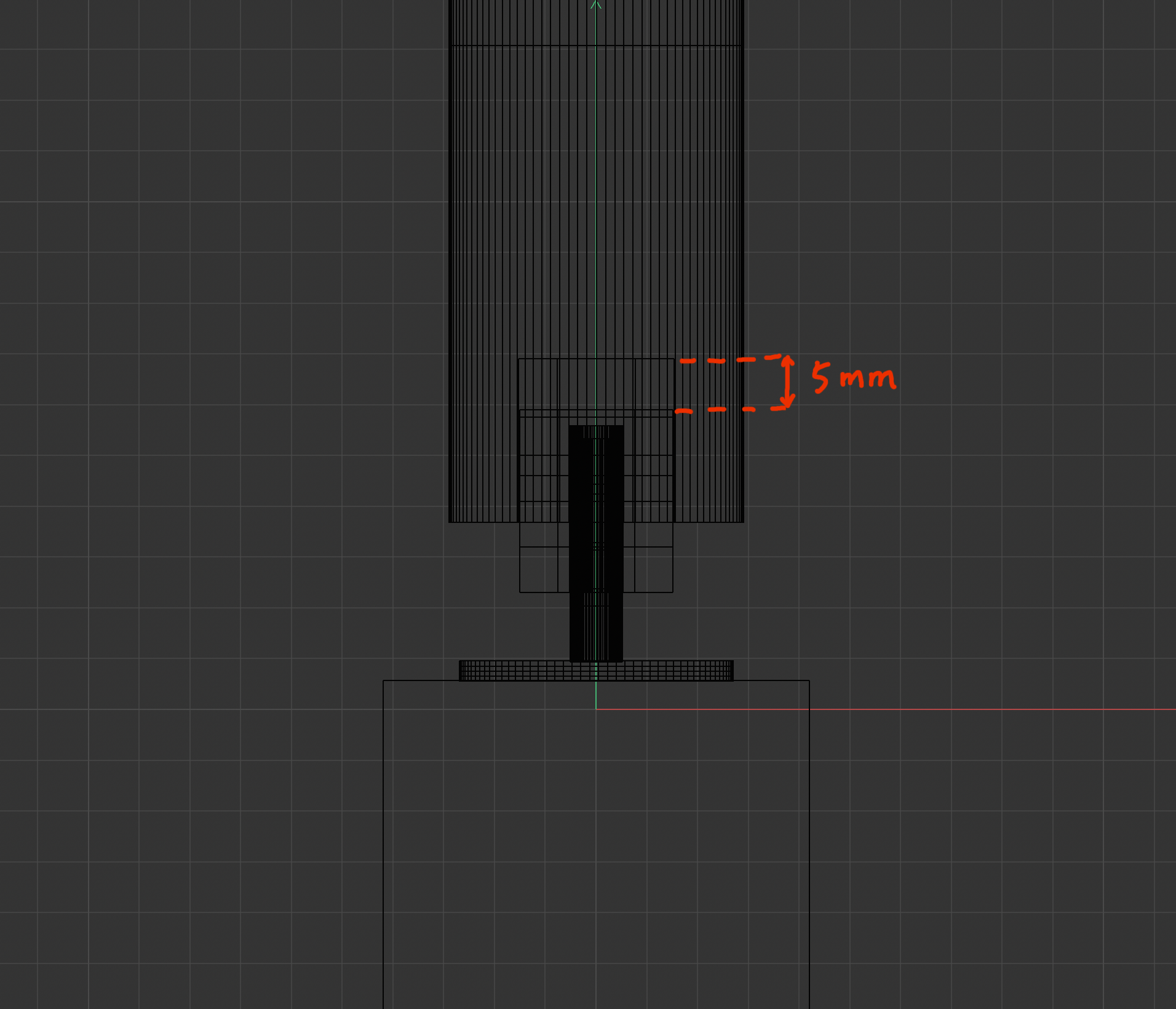
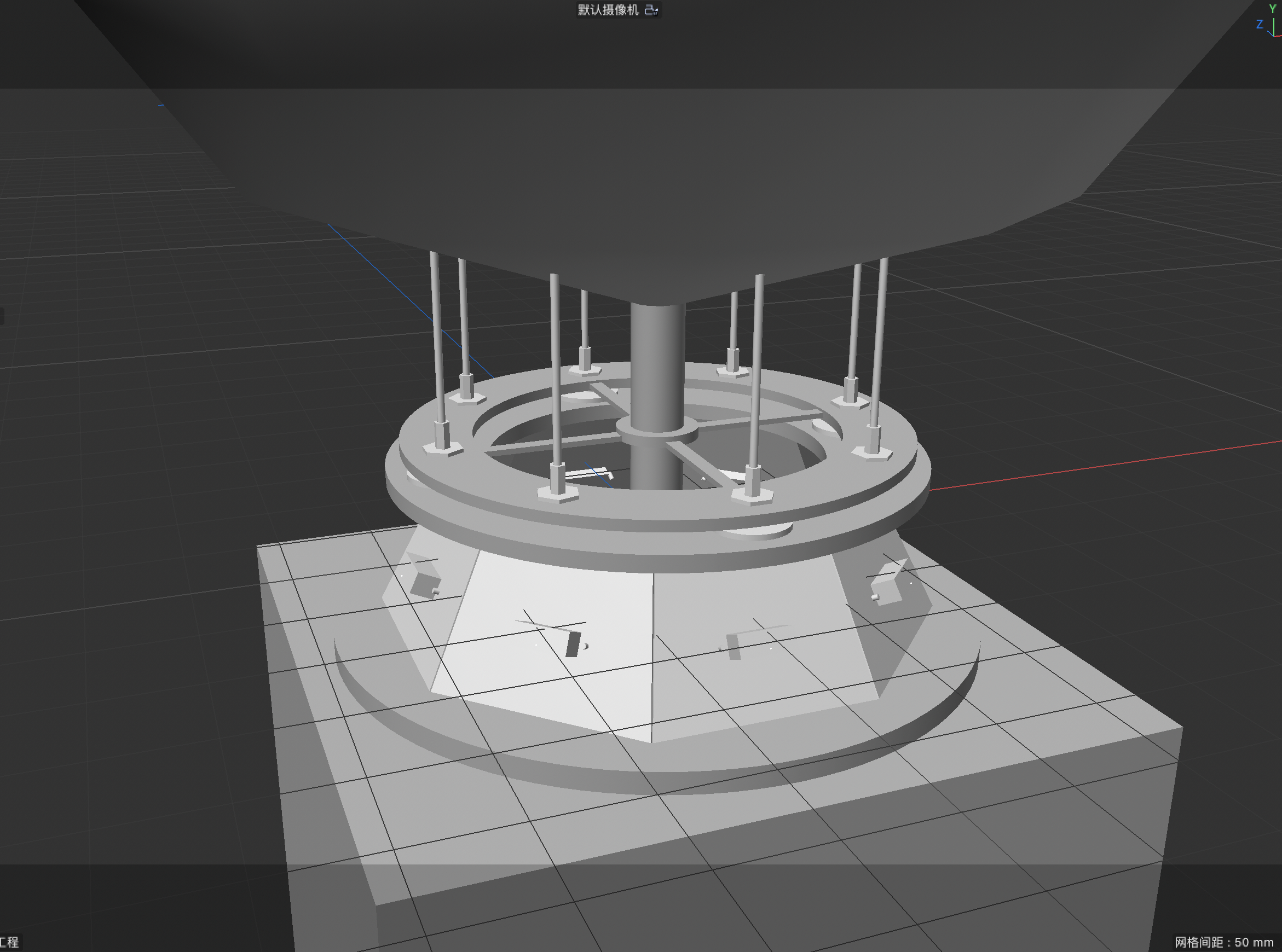





Pictures 2-8: 3D Model Sketching
Contemporary installation artists have indeed embraced the concept of using found objects in their installations to express ideas in broader scopes and innovative ways (Akpang, 2021). After analyzing and comparing the advantages and disadvantages of different presentation methods applied to sphere-based installations, I realized that the weight and electric requirement of screens and projectors are not acceptable for this project. Therefor I concluded that collages made from printed materials offer the best operability. I plan to collect printed materials containing different viewpoints to create collages. By incorporating found objects, I can infuse the installations with layers of meaning and cultural references, engaging viewers in a dialogue that goes beyond traditional boundaries (Huang, 2016). By guiding viewers through different viewpoints, they can explore the concepts of reality and fiction. Since I have not yet collected specific information to present at this stage, I used artist Barbara Kruger's work for a pre-rendering test (picture 9&10). I believe Barbara's concept transmission and presentation style offer aspects I can learn from (analyzed in context “Barbara Kruger and Artworks”)
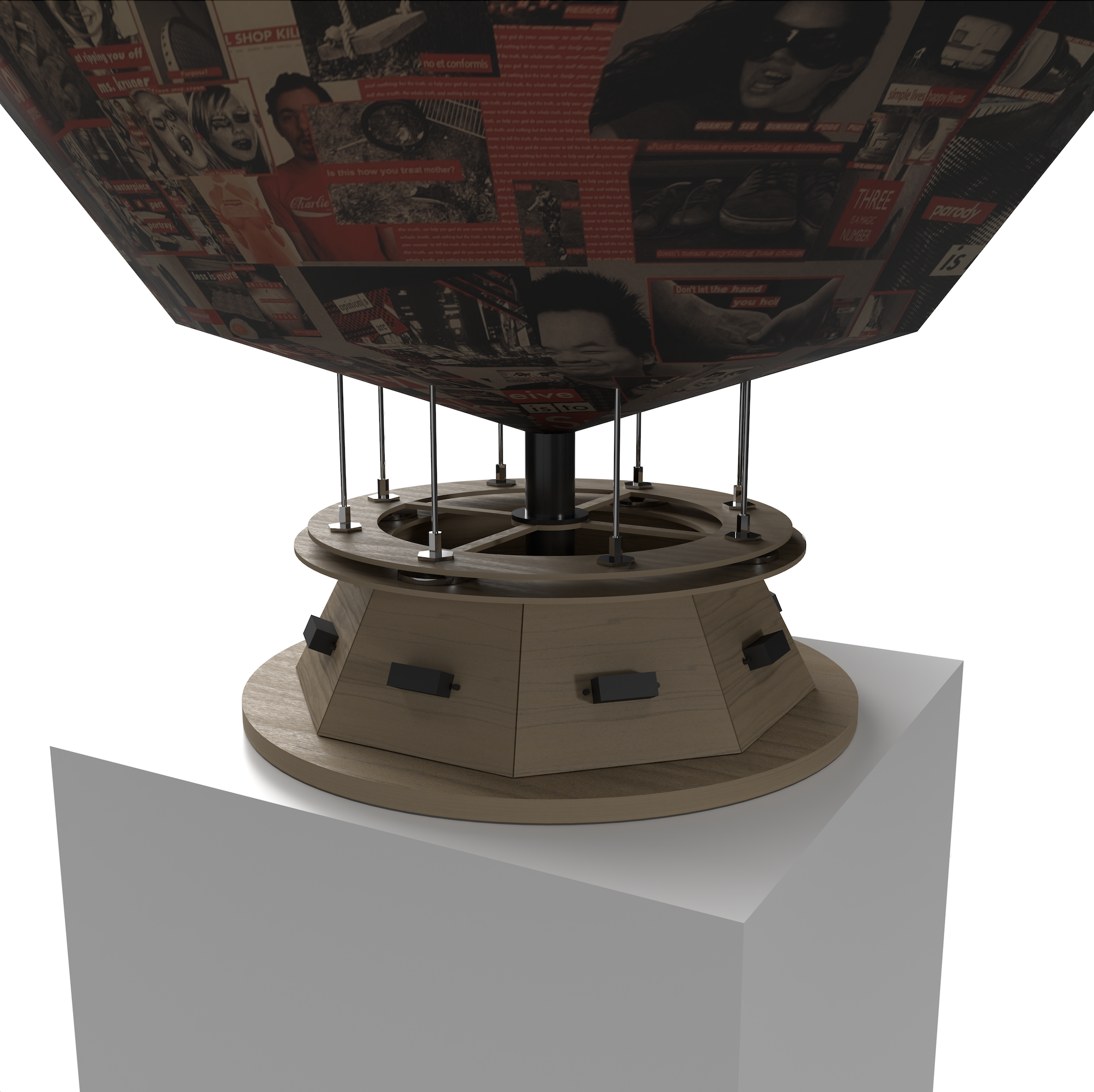
Picture 9 and 10: 3D Model Rendered with Barbara Kruger’ Work
Main Body Production (see full ditails here)
Following the Iterative Design and Testing methodology, the production process was nonlinear and required testing and adjustments based on the progress of each part. However, to express these parts more logically, I will discuss them separately here.
Based on the dimensions of the earlier 3D models, I drew blueprints for the required parts and used the Digital Fabrication team's laser cutter for processing. Thanks to the hardness of MDF material and the precision of laser processing, most components were usable. Since the laser cutting machine could only perform vertical cuts, the 8 pieces with angled edges around the installation had to be manually crafted. With the technician George's help, I finally measured the target angle after several failures and successfully processed usable parts using the wood workshop's cutting machine. Picture 11 shows all the MDF items produced during this stage.
Following this, I began making the sphere. To reduce the overall mass of the sphere and ensure more stable operation of the installation, I chose lightweight and malleable foam glue as the material. I borrowed the working method of 3D printers to produce each layer separately, ensuring each layer was a relatively standard circle (picture 12). However, when I tried to assemble them together, I still found a significant gap from the perfect sphere I had envisioned. This made subsequent refinement work necessary.
The original electronic equipment was replaced with an Arduino Mega (providing 16 analog interfaces), eight infrared distance sensors (detecting the presence of viewers in eight directions), 42mm stepper motors (providing greater power to rotate the installation), and DRV8825 (a driver for high-power motors). Video 3&4 shows the scene of testing this set of equipment. Picture 13 shows the composition of the code.

Picture 11: MDF Items
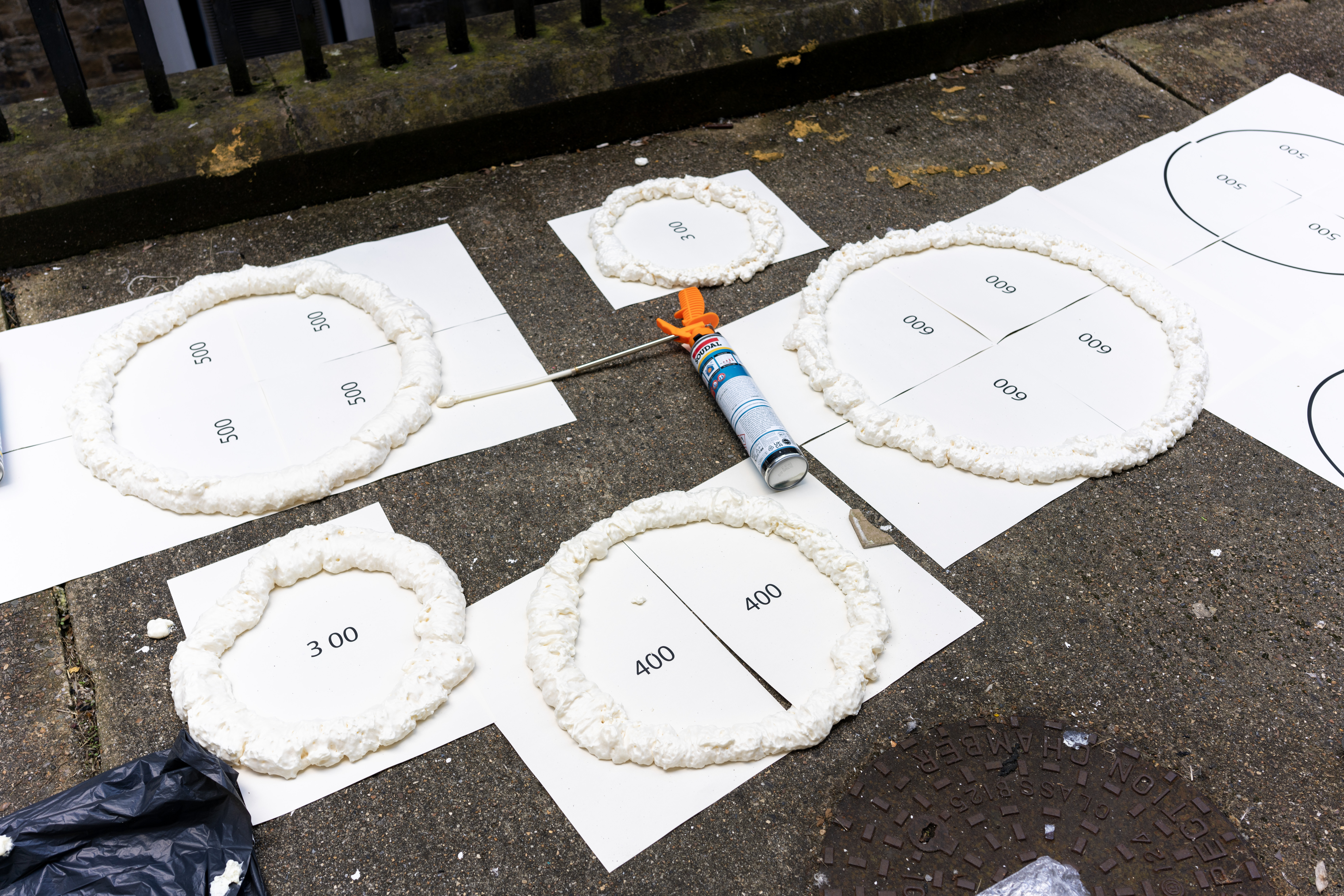
Picture 12: Foam Circle

Picture 13: Coding Test Sketch
Video 3: Device Testing (1)
Video 4: Device Testing (2)
I noticed some limitations in the device's interaction:
(a) The rotation speed was a fixed value. Changing the state of motion of an object required sufficient force to overcome its inertia. When carrying a large mass, the sudden start and stop of rotation required more force than the motor could provide, resulting in missed steps and incorrect rotation angles.
(b) The device always had to finish one rotation command before it could start receiving signals about the viewer's new position. This led to untimely interactions, sometimes causing the viewer to have already moved past several positions that should have been detected, but the device was unable to keep up. This phenomenon led to a decline in the interactive experience.
At this point, there was not enough time before the Copeland exhibition to replace the motor and driver with more powerful ones. To address these two issues and improve the interactive experience, I focused on programming improvements. I tried to optimize the motor's movement by writing an "S" type acceleration and deceleration process. The gradual acceleration and deceleration during operation would reduce the motor's overload caused by inertia at the start and end of rotation. Additionally, I attempted to write a task termination function. This function required the system to immediately terminate the previous rotation task when detecting a new position of the viewer, maintaining rotation speed and stopping at the new target position. I hoped these improvements would enhance the smoothness of the device's movement and thus improve concept transmission and interactive experience.The improved full code is shown in pictures 14-17.




Pictures 14-17: Full Code (final version)
After adjustments and testing, issue (a) was significantly alleviated. However, issue (b) remained unresolved after several modifications to the code logic. I was unsure if this was due to hardware limitations. Video 5&6 shows the appearance of the main body part after production.
Video 5: Main Body of Installation
Video 6: Main Body of Installation
Installation Appearance Design and Showcase
Disinformation and post-truth concepts related to power have become increasingly prevalent in various contexts such as politics, pandemics, and social media (Lewandowsky et al., 2017; Das & Ahmed, 2021; Aliman & Kester, 2020; Wahyudi & Mahaswa, 2022). When the production process reached the stage of exterior decoration, I chose controversial events and news mixed with truth and falsehood, such as the American moon landing and using bleach injections to prevent COVID-19 (Cole et al., 2022; Swami et al., 2017). To enhance the audience's receptivity and better identify these contents, I summarized most of this information from interviews and questionnaires with people around me and famous events on the internet. I unified their tones into a black and white theme to better match and selected attractive article titles to print. To improve guidance for the audience, I mixed in some instructive phrases, such as "are you sure you have seen both?" and "maybe the truth is on the other side." (However, feedback from the exhibition showed that not many people noticed the instructive signs because they were not prominent enough.) I randomly sprayed black and red paint on the sphere's surface wrapped in printed materials. I hoped this blurring effect would slightly increase the difficulty for viewers to obtain information, expressing the concept that trying to explore the truthfulness of information is never an easy process. In the artistic and cultural works of the Asian region, red is closely linked to power (Dong, 2023; Liu, 2022; Wu et al., 2018). Some scholars have also confirmed that red in artistic creation carries meanings of danger, anger, and alertness (Umam & Nirmala, 2020; Braun et al., 1994). Therefore, I continued using the red elements from my Unit 1 practice. The entire sphere was wrapped in red yarn, creating a visually oppressive and tense atmosphere, also suggesting the state of our received information being manipulated and overshadowed by power.
Video 7: Final Installation and Interaction

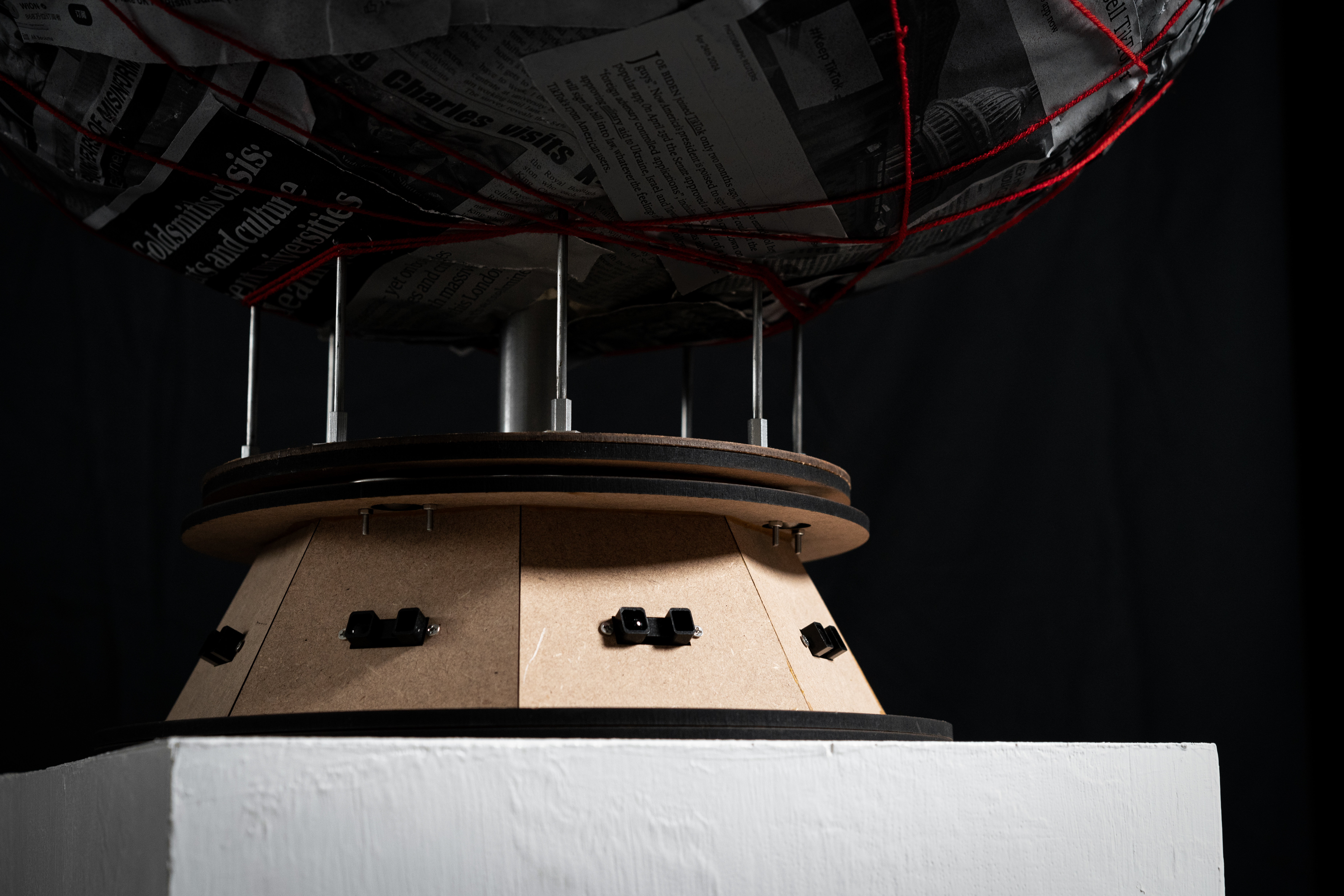




Pictures 18-23: Final Installation
Darkside of the Moon, Roy Jianing Cheng (2024), Interactive Installation.
Printings, MDF, foam, Metal Rod, 3D Printings, Arduino, Sensors and Stepper Motor.
Printings, MDF, foam, Metal Rod, 3D Printings, Arduino, Sensors and Stepper Motor.
Artwork Concept
This is an art installation about exploring post-truth and social power. Through rotating, the installation tries to face the audience with one side. This work symbolically expresses the impact of network censorship and centralised social discourse power on public information access and the singular perspective it presents. I was inspired by the fact that the moon always shows only one side to earth. We can only see the illuminated side, while the other side remains forever hidden in darkness. Similarly, in the public sight, things often only show the single perspective to people. We do not know what the truth is, or whether the truth exists. Just as the dark side of the moon is never seen by us, many truths in society are deliberately concealed. Even if individuals try to explore other perspectives, the result is often unsuccessful. This artwork not only provides an interactive experience but also prompts viewers to reflect deeply on knowledge, information acquisition, and censorship, stimulating profound contemplation on post-truth era and social power.
This is an art installation about exploring post-truth and social power. Through rotating, the installation tries to face the audience with one side. This work symbolically expresses the impact of network censorship and centralised social discourse power on public information access and the singular perspective it presents. I was inspired by the fact that the moon always shows only one side to earth. We can only see the illuminated side, while the other side remains forever hidden in darkness. Similarly, in the public sight, things often only show the single perspective to people. We do not know what the truth is, or whether the truth exists. Just as the dark side of the moon is never seen by us, many truths in society are deliberately concealed. Even if individuals try to explore other perspectives, the result is often unsuccessful. This artwork not only provides an interactive experience but also prompts viewers to reflect deeply on knowledge, information acquisition, and censorship, stimulating profound contemplation on post-truth era and social power.
Copeland Show
The preparation process for the exhibition was not easy, but thanks to the help of the curatorial team, it went smoothly. After discussing the working principle of the installation with the curator, my artwork was placed near the entrance. The installation had three open sides, ensuring that sensors were not affected by surrounding objects and effectively expanding the range of audience movement and enhancing the interactive experience. Although this interactive art installation was designed for use by individual users, considering the limitations of the venue and the public participation nature of the exhibition, I did not mark the range of the installation's sensors on the ground or clarify the rule of one person viewing at a time. This was an experimental attempt for this work.
Putting works in a public exhibition and interacting with the audience was important and challenging. Audience feedback is valuable for the production of interactive installations, allowing artists to assess effectiveness and enhance the installation iteratively based on participants' reactions, ensuring resonance with the audience and alignment with artistic goals (Tong & Kulic, 2021). In my observations and communications with the audience, I found that most viewers recognized that the device was interactive and would stop to observe. The presentation form, mainly consisting of printed materials, effectively conveyed the project's themes, and the audience could understand the topics of conspiracy theories, truth and falsehood, internet information, and political issues. However, some viewers commented that as an artwork, the installation presented information too directly and lacked the associative and open-ended nature of art. Some also thought that presenting social media screenshots in paper media was inappropriate. Additionally, during the exhibition, the interaction aspect of the installation did not perform satisfactorily. There are several reasons for that. First, the motor overheated and weakened after long periods of continuous operation, significantly reducing the smoothness of the installation's rotation and producing clicking sounds during operation. Although some audiences felt that this sound made the installation appear more mechanical, it was contrary to my original expectations. Secondly, considering the weight of the sphere, I adjusted the installation's rotation speed to a lower state. The slow operation meant the rotating sphere could not keep up with the movement of viewers to new positions. These limitations significantly reduced the installation's interactive properties and prevented the audience from having a good experience.
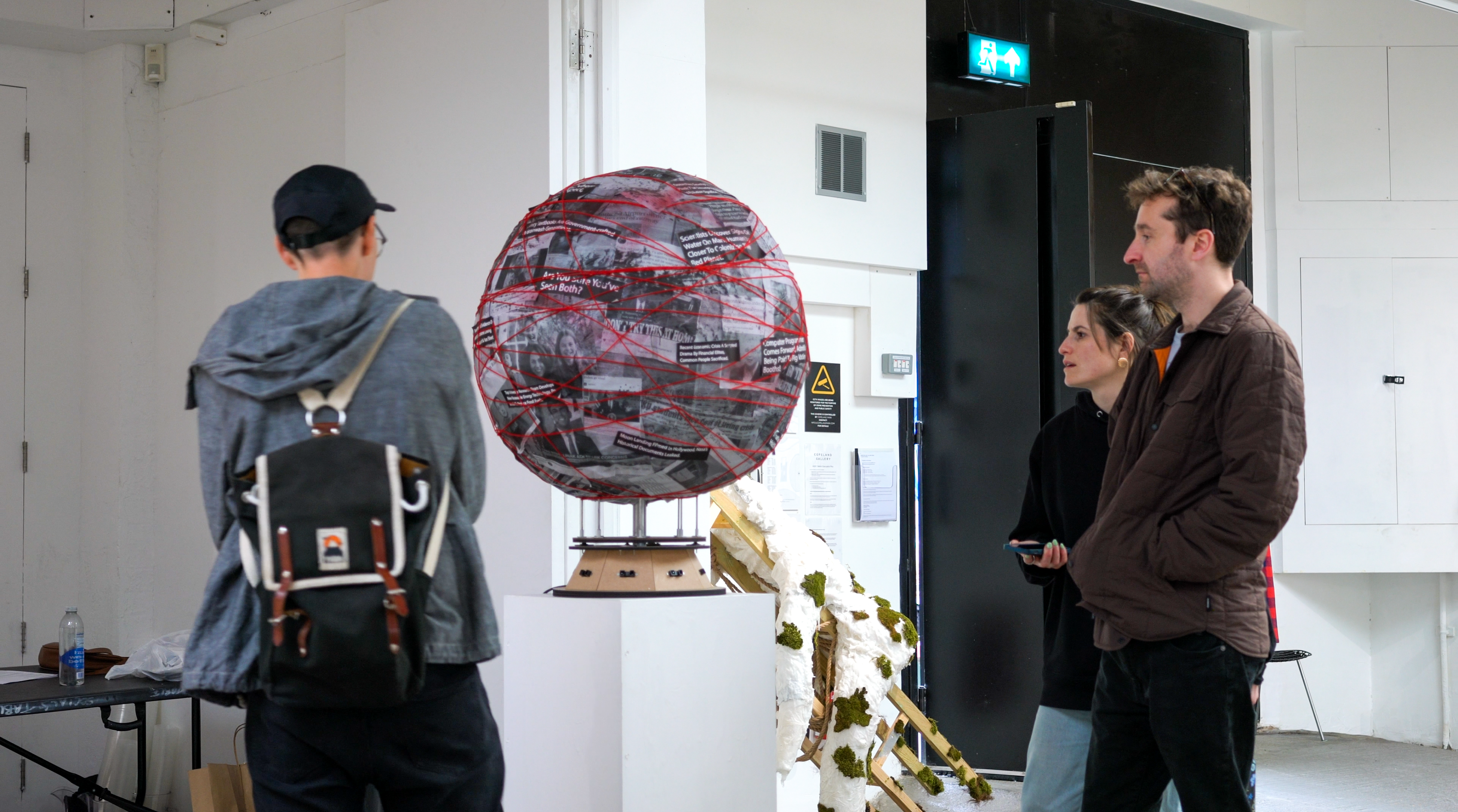




Pictures 24-28: Installation in Copeland Show
Darkside of the Moon, Roy Jianing Cheng (2024), Interactive Installation.
Printings, MDF, foam, Metal Rod, 3D Printings, Arduino, Sensors and Stepper Motor.
Printings, MDF, foam, Metal Rod, 3D Printings, Arduino, Sensors and Stepper Motor.